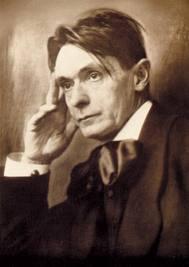Rudolf Steiner

Looking at the scope, depth and far reaching influence of Steiner’s work it comes as no surprise that he has been compared to figures like Aristotle and Thomas Aquinas.
Just like Aristotle’s thinking laid the foundations to science and philosophy in antiquity and continues to influence us to this day, and again just how Thomas Aquinas’ Christian reinterpretation of Aristotelian thought provided the theological foundation to Catholicism, which also continues its influence to this day, so has Steiner’s extraordinary research as a spiritual scientist been able to re-unite western spirituality and science, which had grown apart and been in contradiction of each other. In this he laid the foundations for a renewal of western culture and thinking that is likely to cast its influence far beyond his life time, possibly continuing for centuries into the future.
Rudolf Steiner (1864 – 1925)
Steiner, therefore, is not another new age Guru formulating yet another theory for a devoted fringe audience, but a towering historical figure, whose influence is pulsing within the very heart of cultural life and mainstream western civilization.
The spiritual view of the human being and the universe which Steiner taught is generally known as Spiritual Science or Anthroposophy. Steiner himself described Anthroposophy as a “path of knowledge to guide the Spiritual in the human being to the Spiritual in the universe”[1]. His indications and teachings have given rise to many new, spiritually informed practical endeavors. Anthroposophically oriented institutions and initiatives have been established and continue to grow all over the world and in all spheres of cultural life, from education to agriculture, from medicine to the natural sciences, philosophy to religion, political science to history, as well as in architecture and the broad range of performing and visual arts.
Steiner’s collected works comprise over 300 volumes[2], the majority of which are transcripts from over 6000 lectures ranging on the wide range of subjects reflected in the above initiatives.
In philosophical terms, Anthroposophy could be described as a form of spiritual monism, which sees the physical universe as a condensation out of a much larger, creative and highly conscious, spiritual universe. In practice this means that every physical object, being or phenomenon is at the same time also connected to an underlying spiritual reality. This reality however does not exist in a remote and separate, abstract realm but is concretely present within and around visible physical reality, much like the visible tip of the iceberg, which also has no separate existence removed from the ocean or the larger body of ice hidden below the surface.
